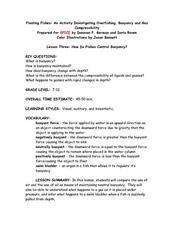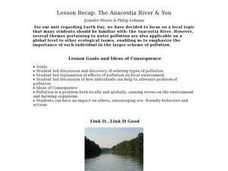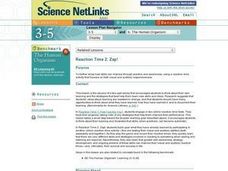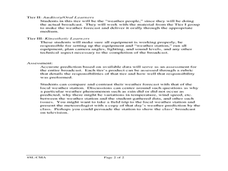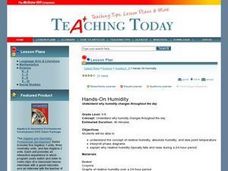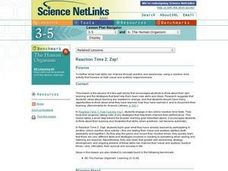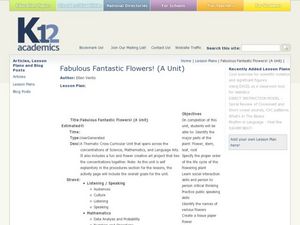Howard Hughes Medical Institute
How Animals Use Sound to Communicate
Communication involves the visual, auditory, olfactory, and tactile senses. Scholars observe groups of animals communicating through multiple senses. They note and learn why different species use different senses depending on their...
Curated OER
Determining Cutting Site Locations
Students explore DNA restriction mapping. They cut pieces of paper into lengths representing those produced when specific enzymes are used to cut a strand of DNA.
Curated OER
Learning About Sounds
Students determine the sources of sound. In this auditory discrimination activity, students listen to animal noises and various other noises. As students listen, they identify the sounds that they hear.
Curated OER
Learning About Sounds
Learners practice identifying different sounds. In this auditory skills instructional activity, students listen to items that make different sounds. Learners discuss the sounds of different items and try to identify the sounds they hear.
Curated OER
Floating Fishes: How do Fishes Control Buoyancy?
Playing with balloons, water, oil, and bottles help put this lesson over the top! Participants use air-filled balloons in water tanks to experience gas compression. They also use oil-filled bottles to experiment with buoyancy. Included...
Perkins School for the Blind
The Mystery Box - Making Observations and Collecting Data
Making observations and collecting qualitative and quantitative data is a vital skill all scientists need to practice. Help your scientists with partial and no sight learn how to use their other senses to make observations for...
Curated OER
Lesson Recap: The Anacostia River & You - Biology Teaching Thesis
Seventh graders give examples of local sources of pollution and postulate reasons as to why local sources of pollution can harm the ecosystem. They address the following question in short answer form: "Why is litter/chemical pollution...
Core Knowledge Foundation
A Time for All Seasons - Winter
As the days get shorter and a chill enters the air, it's time to start teaching your little ones about the wondrous winter season. Through a series of teacher demonstrations, whole-class read alouds and discussions, and hands-on...
Curated OER
QR Coded Audio Periodic Table of the Elements
Take the periodic table into the digital age with QR codes that take the scanner to an audio recording about each element from the Royal Society of Chemistry. Enlarge the image, then use a smartphone or tablet to scan the code for an...
Curated OER
Do You See What I See?
Students engage in a instructional activity that differentiates between right and wrong types of observations. In order to conduct the experiment they are provided with leaves and nameless objects with different designs. The two are...
Curated OER
Calendar Time
Use circle time to work on counting. Kindergarteners practice the months of the year, say the full date, chart the day's temperature, count to 100, and sing the alphabet song. This kind of daily routine cultivates deep roots for...
Curated OER
English Exercises: Listening about Tornadoes
Engage visual and auditory students with a 4-minute video on tornadoes, paired with a comprehension note and activity guide. Learners watch the video and then fill in 15 pieces of information in a chart; determine if 12 statements are...
Curated OER
Reaction Time 2: Zap!
Students show how skills can improve through practice and awareness, using a reaction-time activity that focuses on both visual and auditory responsiveness.
Curated OER
Reaction Time 2: Zap!
Learners explore critical thinking by conducting a reaction time experiment. In this human brain lesson, students utilize a timed Internet worksheet activity to research how fast their brain works when answering questions. Learners share...
Curated OER
Natural Communication
Students investigate communication as an adaptation by examining visual, tactile, chemical and auditory communication. They study the characteristics of the red fox an songbirds.
Curated OER
Nature of Science and Technology
Fourth graders measure weather using different instruments and gather information to make science comparisons. In this weather measurement lesson plan, 4th graders have activities they can complete whether they are visual, auditory,...
Curated OER
Hands-On Humidity
Young scholars examine why humidity changes throughout the day. They study the concept of relative humidity, absolute humidity, and dew point temperature. They interpret phase diagrams and explain why relative humidity typically falls...
Curated OER
Caterpillars To Butterflies
Students observe the life cycle of a butterfly. They read butterfly/caterpillar themed books. They sequence the lifecycle from eggs on a leaf to an adult butterfly. They release their butterflies into a natural habitat after singing and...
Curated OER
The Human Skeletal System: Inside and Out
Students study bone size, structure and shape. They use various geometrical shapes to make a skeleton and produce a poster depicting the skeletal system and its functions. They arrange the pictures into the five sections, glue on...
Curated OER
Shark Attack Odds and the Importance of Sharks
Young scholars examine an ecosystem. In this food web lesson, students discover the importance of sharks and what threat sharks actually pose to humans. They participate in class discussions and work independently on a couple of...
Curated OER
The Frog Experiment
Your science class reads a silly story in which a mad scientist makes absurd conclusions about an experiment that he conducted. One at a time, he cuts off a frog's leg and commands it to jump. With three, two, and one leg, the frog...
Curated OER
REACTION TIME 2: ZAP!
Students explore how skills can improve through practice and awareness, using a reaction-time activity that focuses on both visual and auditory responsiveness.
Curated OER
The Living Environment
Sixth graders show what they know about plant and animal cells. In this cell project instructional activity, 6th graders get to choose a project based on their learning style. They can create a visual representation of cells, auditory...
Curated OER
Fabulous Fantastic Flowers!
Students study flowers and identify their major parts. In this flowers lesson plan, students research flowers, learn about their life cycle, label their major parts, and make tissue paper flowers.




